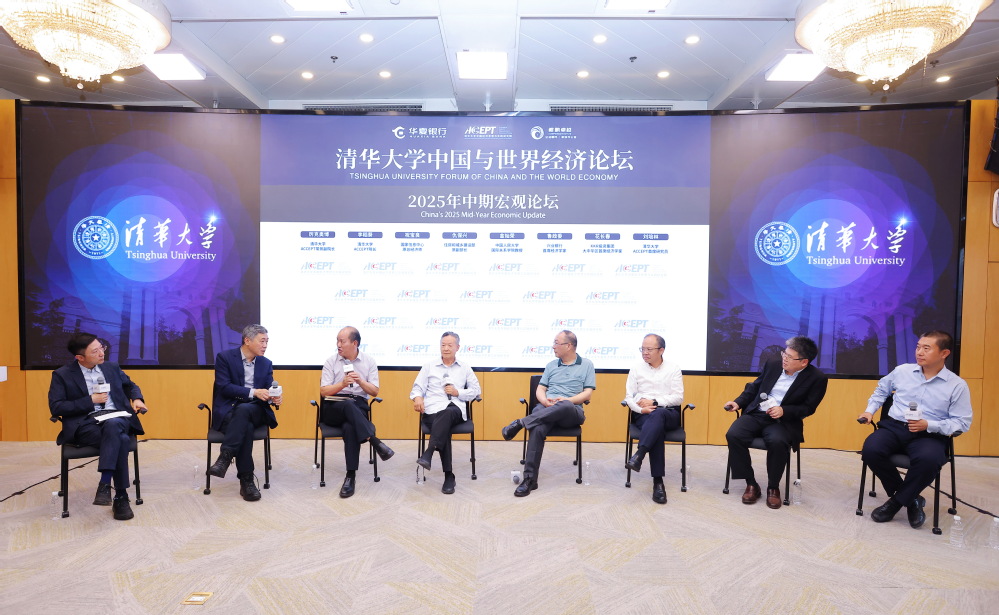China’s 2025 Mid-Year Economic Update: Break free from the restraints of traditional fiscal administration and set in motion a new way of thinking about modern public finance
Originally published July 2, 2025, in Chinese on the ACCEPT website. Translated by ACCEPT.
Source: http://www.accept.tsinghua.edu.cn/2025/0702/c25a7198/page.htm
China’s 2025 Mid-Year Economic Update
49th Tsinghua University Forum of China and the World Economy
On July 2, 2025, the 49th Tsinghua University Forum of China and the World Economy, organized by the Academic Center for Chinese Economic Practice and Thinking (ACCEPT) at Tsinghua University, was broadcasted online. The event’s theme was entitled “China’s 2025 Mid-Year Economic Update.” Guests in attendance at the biannual forum included Hua Changchun, Chief Economist for Greater China at Kohlberg Kravis Roberts & Co. Inc. (KKR); Jin Canrong, Associate Dean and Professor of the School of International Studies at Renmin University of China; Lu Zhengwei, Chief Economist of China Industrial Bank; Qiu Baoxing, Academician of the China Science Center of the International Eurasian Academy of Sciences and former Vice Minister of the Ministry of Housing and Urban-Rural Development of the People’s Republic of China; Zhu Baoliang, former Chief Economist and Researcher of the State Information Center’s Department of Economic Forecasting; David Daokui Li, Director of Tsinghua University’s ACCEPT, Co-President of the Society for the Analysis of Government and Economics (SAGE) and Professor at Tsinghua University’s School of Economics and Management; and Liu Peilin, Chief Researcher at Tsinghua University’s ACCEPT. The Deputy Executive Director of ACCEPT, Li Ke’aobo, presided over the forum’s proceedings.

During the forum, Liu Peilin released the latest China Macroeconomic Analysis and Forecast Report on behalf of the research institute entitled “Breaking Free from the Restraints of Traditional Fiscal Administration and Setting in Motion a New Way of Thinking about Modern Public Finance: A Theoretical Analysis for Facilitating China's Economic Cycle.”
The report pointed out that in the first half of 2025, China's economy has shown some encouraging signs of stabilization and improvement, but with the level of economic growth still proceeding at a pace lower than its potential, and with the resulting impacts on the broader society having since become an important factor that must be taken into consideration when planning the country’s overall development and security.
Current indications of stabilization include the following: (1) a nominal growth rate that has risen to 4.6%, which despite still remaining at a relatively low level, nonetheless represents a further recovery compared with the second half of last year; (2) the continued advancement of industrial upgrading, with the growth of value added and investment in the equipment manufacturing and high-tech manufacturing sectors having been significantly higher than the overall level for all industrial enterprises above the designated size; and (3) a modest rebound in consumption, with the year-on-year growth rate for total retail sales of consumer goods having accelerated compared with the previous month.
As for the risks presently facing China’s economy, they have taken shape in the following forms. (1) The current employment situation does not invite optimism, as the number of employed individuals aged 16-59 as a proportion of each age cohort has generally followed a downward trend over the past 15 years, while the youth unemployment rate itself remains significantly higher than that of Germany, Japan, South Korea, and the United States. Within the broader labor force, the scale of those “flexibly employed” has become comparatively large, with the number of ride-hailing drivers continuing to expand despite the average number of orders per person having steadily decreased. (2) Real estate sales are sluggish, with inventories remaining at high levels and new investment into real estate development continuing to decline. (3) In terms of prices, the GDP Price Deflator, Consumer Price Index, and Producer Price Index are all in the negative, with this downward pressure having now persisted for an extended period of time. (4) "Involution" has gained increasingly more traction as a general phenomenon, which is reflected in the ballooning size of accounts receivable across enterprises and increasingly lengthier collection periods, with the profit margins for operating incomes in the manufacturing industry having declined significantly over the past five years. (5) On the international scene, various incidents have emerged one after another, with many factors contributing to greater instability. Overall, the country’s long-term economic growth potential is being negatively impacted, with public sentiment rendered weaker and social tensions intensifying, which is giving rise to an even greater sense of insecurity.
The report stressed that the central issue behind what is ailing China's current economic performance revolves around “a situation of stagnating vital energy and impaired blood flow”—to borrow the language of traditional Chinese medicine. That is to say, the country is currently suffering from persistently high levels of local government debt that far outstrip local authorities’ respective capacities for fiscal management and tax collection. Under the pressure of debt repayment, local governments have had no choice other than to further expand their efforts to collect tax and non-tax revenues from local enterprises and residents, which has in turn contributed to stifling the initiative of businesses and households. At the same time, the funds amassed by local governments for debt repayment are all being concentrated in the financial sector, with such funds not being made available in that sector for reinvestment into the businesses and households now experiencing a slump. In other words, high levels of local government debt have brought about a stagnation in economic and financial operations, with the accumulation of liquidity penned up in financial institutions moreover contributing to poor economic circulation.
The report argues that remedying the situation outlined above first requires a shift in present policy thinking—namely, by replacing traditional fiscal administration with modern public finance. Traditional fiscal administration is principally concerned with the short-term balancing of fiscal resources, while the more modern concept of public finance requires that governments undertake the following: 1) provide the financial market with access to government bonds that offer the greatest liquidity and the highest credit rating, while serving as the base of the financial market pyramid, so as to take into consideration and resolve financial and fiscal problems in an integrated manner; 2) evaluate whether to make funding available through the issuance of government bonds from the perspective of the country’s statement of assets and liabilities, instead of merely considering its statement of cash flows during any given period; and 3) set a goal of balancing revenues and expenditures in the long term rather than in the short term. At this present moment, the research institute is of the opinion that conditions are suitable in China to move forward with a large-scale issuance of government bonds by the central government, i.e., national-level debt securities otherwise known as central government bonds or "sovereign" bonds.
Based on the aforementioned analysis, and in accordance with the spirit of pursuing “a more proactive fiscal policy” as proposed by the central authorities, ACCEPT has put forward a suite of recommendations to support the issuance of central government bonds with an aim towards facilitating the smooth functioning of China’s economic cycle, supporting its advance towards a new period of high-quality and moderately-paced development. The recommendations are as follows: 1) issue 30 trillion yuan in sovereign bonds to replace local government debt; 2) issue 4 trillion yuan in sovereign bonds to lend funds to local governments for the purchase of housing stock, absorbing surplus real estate inventories and converting these units into affordable housing; 3) issue 1 trillion yuan in sovereign bonds to assist enterprises dealing with production overcapacities to cycle between older and newer production throughput as soon as possible, expediting the process of market clearance; 4) issue 1 trillion yuan in sovereign bonds to support consumption as well as the renewal and replacement of outdated equipment; and 5) issue 1 trillion yuan in sovereign bonds annually for a 10-year period, lending these funds to lower-level governments in those localities experiencing population inflows and supporting local governments in their push to urbanize migrant workers.
During the subsequent roundtable discussion segment of the forum, each of the invited guests launched into an exchange of views on a range of recent hot topics concerning the domestic and international scenes.
Zhu Baoliang cautioned that despite China's economy having at present generally shown a trend towards stabilization, such encouraging signs are mainly being underpinned by ongoing policy support, with the momentum of endogenous growth remaining insufficient and the rebound in consumption largely remaining reliant on policies such as “trade-in” schemes. In terms of the real estate sector, following the introduction of the “three-year guaranteed timely delivery of presold homes” policy, the market began to show some signs of recovery, especially in first-tier cities where prices for newly-built housing units began bouncing back to some extent. However, the prices for pre-owned residential properties are still tracking downwards, which means that the market’s overall trend has not yet been stabilized. He suggested focusing on the liquidation and revitalization of leftover non-residential properties, including by making use of Real Estate Investment Trusts (REITs) and other means to put idle and unused funds to work, in this way further promoting a recovering in the real estate market.
The persistent decline in prices that characterizes the current performance of China’s economy is a reflection of weak domestic demand, languishing confidence, an ongoing corporate liquidity squeeze, and broken balance sheets, among other issues. As such, the current market may not be in a position to begin correcting itself without the intervention of more robust fiscal measures. When it comes to tracing some of the underlying reasons for the country’s current economic state, moreover, Zhu mentioned that the uncertainties created as a result of the external environment, declining imports and exports, and escalating frictions between China and the United States continue to constitute risk factors.
On a theoretical level, Zhu expressed that it is necessary to re-examine the thinking behind macroeconomic theories, including in reference to declines in the marginal propensity to consume, diminishing investment efficiency, and balance sheet recessions, among other areas, introducing measures in accordance with the appropriate steps to address specific issues as they crop up. In addition, he stressed the need to maintain a robust fiscal policy while clearly clarifying the direction of reforms to avoid falling into a prolonged period of downturn like Japan.
Qiu Baoxing noted that there is still ample room left for China to implement policies to regulate and control the real estate sector, with the country’s institutional advantages concentrated and embodied in its harmonized system for coordinating regulations and controls between central and local governments. Compared with the structural limitations placed on the private land tenure system in Western countries, China has granted its local governments with certain functions as “investment entities,” which has led to the creation of a policy multiplier effect through a mechanism for redistributing the gains from land use. At present, there is an urgent need to systematically improve abilities to apply policy tools, including solving the problem of path dependency among some local governments. On the issue of liquidating housing stock, the model for supplying affordable housing has already laid the groundwork necessary for purchasing and stockpiling converted residential units, although there are three obstacles that must be overcome before proceeding to implementation. First, the lack of a market-orientated pricing mechanism generates a conflict between the goals of preserving asset values on the one hand and liquidating excess housing stock on the other hand. Second, the local-level housing development system suffers from functional inertia as a result of its tendency to “overvalue new construction and undervalue revitalization.” Third, there are institutional gaps that remain for transforming the commercial real estate sector.
He pointed out that the real estate market is currently at a stage of undergoing structural readjustment, with the momentum behind the reorganization and restructuring of real estate developers having become increasingly more evident. The policy guidance will focus on cultivating first-rate property developers with a capacity for product innovation, while transforming the supply ecosystem for “quality housing” through the establishment of a classification support system. The key to innovating on financing mechanisms is to guide real estate developers and local government financing vehicles to institute a collaborative model of “asset-light operations + special-bond financing,” which can effectively ameliorate the problem of financial institutions engaging in credit discrimination against real estate enterprises. From the perspective of long-term dynamism and freeing up liquidity, it is necessary to focus on activating financing engines that comprise the three following major components: first, establish a cross-regional circulation mechanism for social security to tap into the potential housing consumption of 100 million members of the migrant population; second, innovate on the model for the voluntary reconstruction of older communities, including by leveraging social capital with a policy of extending the term length for property rights and compensating for any changes in the floor area ratio; third, develop the long-term rental market for rural housing, utilizing the “20+10” lease system and rent control mechanisms to protect the rights and interests of residents, which is expected to drive an average annual investment of 4 trillion yuan.
In reference to the differentiation of regional markets, Qiu suggested that young people's housing purchase decisions should follow the principle of “rigid demand first,” placing emphasis on the anchoring of excess premium effects associated with resources devoted to education and medical care. Empirical analysis indicates that the current systemic risks to the market are significantly lower than they were at the peak of the historical cycle, however it is still necessary to guard against the risk of impacts on asset values arising from negative externalities. Policymakers should strengthen the institutional flexibility of central-local coordination, stimulate the momentum of grassroots innovation through fault tolerance mechanisms, and ultimately realize the transformation of the real estate market towards the direction of high-quality development.
Jin Canrong pointed out that China-US relations have now shifted from the “United States attacking and China defending” towards a “strategic stalemate.” Against the backdrop of progressively increasing its national strength, as well as its steady breakthroughs in high-end manufacturing and key technologies, China has gradually positioned itself to seize the initiative. Although the US remains the sole global hegemon, the country’s overall capacity to maintain its dominance over the international scene has declined, while its alliance network and domestic governance have both shown indications of instability.
At the level of the international order, the world is now experiencing “great changes that have not been seen in a century,” which is being manifested as the “rise of the East and the fall of the West.” Emerging economies such as China, India, and members of the Association of Southeast Asian Nations (ASEAN) are in the process of rising rapidly, while Europe and Japan are both in a state of relative decline. Jin asserted that despite the international situation being as complex and changeable as it is, the probability of a “black swan event” that has the potential to have a major impact on China remains limited. Ultimately, the ongoing transformation of the global economic situation will depend on China's own domestic growth and stability: such that a prolonged economic downturn would likely lead to the emergence a variety of different social contradictions. Therefore, maintaining an upward trajectory for economic growth and stabilizing improvements in domestic demand are of paramount importance.
Lu Zhengwei first analyzed the current situation and structural problems facing China's financial market, having pointed out that the overall financial picture was beginning to improve despite sluggish credit growth. While the growth rates for credit, M2 and total social financing all remain at historically low levels, each indicator is more or less aligned with the growth rate for nominal GDP, and yet when domestic and foreign equity financing is included in the mix, the actual corporate financing situation appears much more promising than that demonstrated by the surface-level data. At present, there are three main factors that have contributed to a decline in China’s loan demand. First, as local government financing vehicles have increasingly turned to the issuance of bonds, the real estate industry has in turn undergone a readjustment, with the demand for bank loans therefore having decreased markedly. Second, domestic enterprises are in the process of accelerating the internationalization of their operations, with the center of gravity for new investments having shifted towards overseas markets, thereby contributing to a weakening in the demand for domestic financing. Third, as the structure of China's economy continues to transform, the approach to financing has similarly undergone a change, and while companies still most definitely need access to capital, loans can no longer adequately meet their needs. When it comes to large domestic enterprises, there is a general preference for equity financing over loans when conducting cross-border mergers and acquisitions. As for small- and medium-sized enterprises, these entities often cannot cover the interest on loans in the early stages of their operations, which generates constraints as a result of a mismatch between the credit model and the business growth cycle, among other factors, which forces enterprises to rely on private financing instead to fulfill their needs.
Hua Changchun explained that foreign capital adheres to the principle of profit-seeking, with the question of whether or not investors are optimistic about Chinese assets depending on the degree to which fiscal policy is ramped up. If relevant policies can provide a boost to public confidence, then foreign capital will begin to flow back. At present, China's economy is facing multiple challenges: such as the likelihood of added pressure exerted on the manufacturing sector from tariffs, an ongoing slump in real estate sales and consumption, declines in employment and incomes, and a potential further downgrade to economic growth. In response, policies first and foremost need to be directed towards increasing people's incomes and overall confidence moving forward into the future, especially with regards to addressing the employment concerns facing young people as well as countering the country’s continued deflationary slide, all of which will help to attract foreign investment. Although most foreign capital is currently engaged in short-term trading and longer-term investments remain underallocated to Chinese assets, the market has now reached a consensus for the third time on the overvaluation of the US dollar. In the past, two of the previous overvaluations historically have led to capital outflows. This time around, meanwhile, the direction of the outflow from US dollar assets will be decided by the availability of alternative investment assets. If China's policy direction further improves and asset values rise, the inflow of US dollar funds into China may accelerate. China meanwhile needs to focus primarily on policies that support domestic demand rather than relying on steering exchange rates.
He also mentioned that many observers have been keen to compare China's present economic situation with that of Japan’s some 30 years ago, but there are in fact three significant differences between the two. First, the per capita GDP of China is currently only 16% that of the US, which is a level that does not coincide with Japan's at that time, with its per capita GDP having exceeded that of the US. Second, China is able to benefit from new growth drivers, such as the green revolution and AI revolution, while the country garners certain competitive advantages vis-à-vis the rest of the world. Third, compared with Japan, the overall size of China's economy is much larger and possesses more growth potential, with the country’s broader society moreover showcasing relatively stronger vitality.




